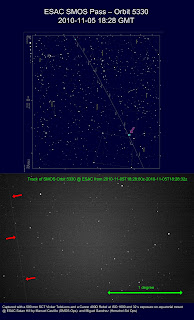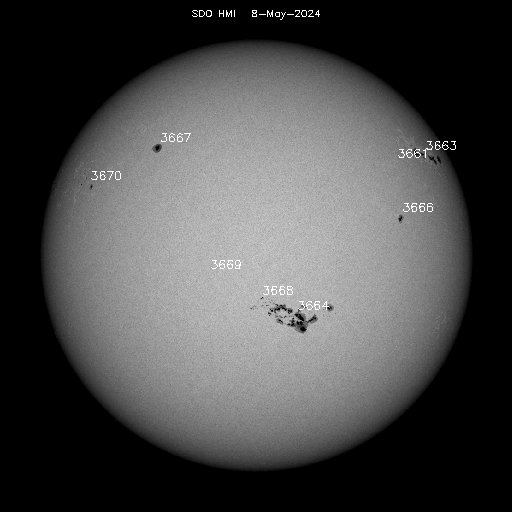Last Friday, Miguel and me were at ESAC to perform some imaging& tracking test with our equipment in a new edition of the Friday's experiment "program". Between the targets that we selected, we tried to image the track of SMOS. Predictions can be done easily by everybody using the heavens-above website to forecast the passes of LEO satellites. Thus we detected pass over Valencia suitable to capture an image of the track: satellite-to-ESAC range around 1000 km and eastern pass, i.e. illuminated over dark sky. Finally, we tried and the following image was captured by us using a 500 mm. SCT Vivitar Telelens and a Canon 400D Rebel at ISO 1600 and 30 seconds of exposure.
 I have been working with the image to try to estimate the SMOS intrinsic magnitude (not reported yet). It can be very useful for SSA and other operational events, specially in the case when a satellite must be localized to have an independent orbit assessment (e.g. a satellite radio black out... like in the case of XMM recovery. But, I must recognize that the capture was not a well planned experiment. As at that moment I was not sure about the effective field of view of the telelens, the imaged area didn't covered enough good stars to localize easily reference star brightness. In this case, it is very difficult... even with the Mount Palomar Survey plates... ;) ... Apart from the field distortions introduced by the SCT Telelens (no field correction, vigneting, etc), the main difficult was that not all the star-like features are real stars... With the fast changes of arrangement... I forgot to take some flats and darks and now I cannot discriminate these features... sometimes they can be well identified with the colour but in this case the image was taken in gray! In consequence and resuming, I'm afraid that by now I can forget to use these images to derive the intrinsic SMOS magnitude. However, some lessons can be learned from this experience for the next trials that for sure, we will perform very soon...
I have been working with the image to try to estimate the SMOS intrinsic magnitude (not reported yet). It can be very useful for SSA and other operational events, specially in the case when a satellite must be localized to have an independent orbit assessment (e.g. a satellite radio black out... like in the case of XMM recovery. But, I must recognize that the capture was not a well planned experiment. As at that moment I was not sure about the effective field of view of the telelens, the imaged area didn't covered enough good stars to localize easily reference star brightness. In this case, it is very difficult... even with the Mount Palomar Survey plates... ;) ... Apart from the field distortions introduced by the SCT Telelens (no field correction, vigneting, etc), the main difficult was that not all the star-like features are real stars... With the fast changes of arrangement... I forgot to take some flats and darks and now I cannot discriminate these features... sometimes they can be well identified with the colour but in this case the image was taken in gray! In consequence and resuming, I'm afraid that by now I can forget to use these images to derive the intrinsic SMOS magnitude. However, some lessons can be learned from this experience for the next trials that for sure, we will perform very soon...To avoid tracking problems:
- Select the equipment: field of view (FOV) is very important!
- The equipment must be stationed carefully... not in 15 minutes!
- Analyse and Plan carefully the areas crossed by the track to be able to change from one area to another. In this case, I tried first with a well prepared area close to Cassiopea but the capture failed due to a FOV problem (not well known for the used SCT Telelens). After the fail I moved very fast to Pegasus without enough time to assure the pass and identify the area. Fortunatelly, it was catched up!
To reference the images: The FOV should be wide enough to capture bright starts easy to identify in the catalogues: preferably tracing constellation stars.
To correct the images: some darks and flats must be taken just after or/and before the imaging.




